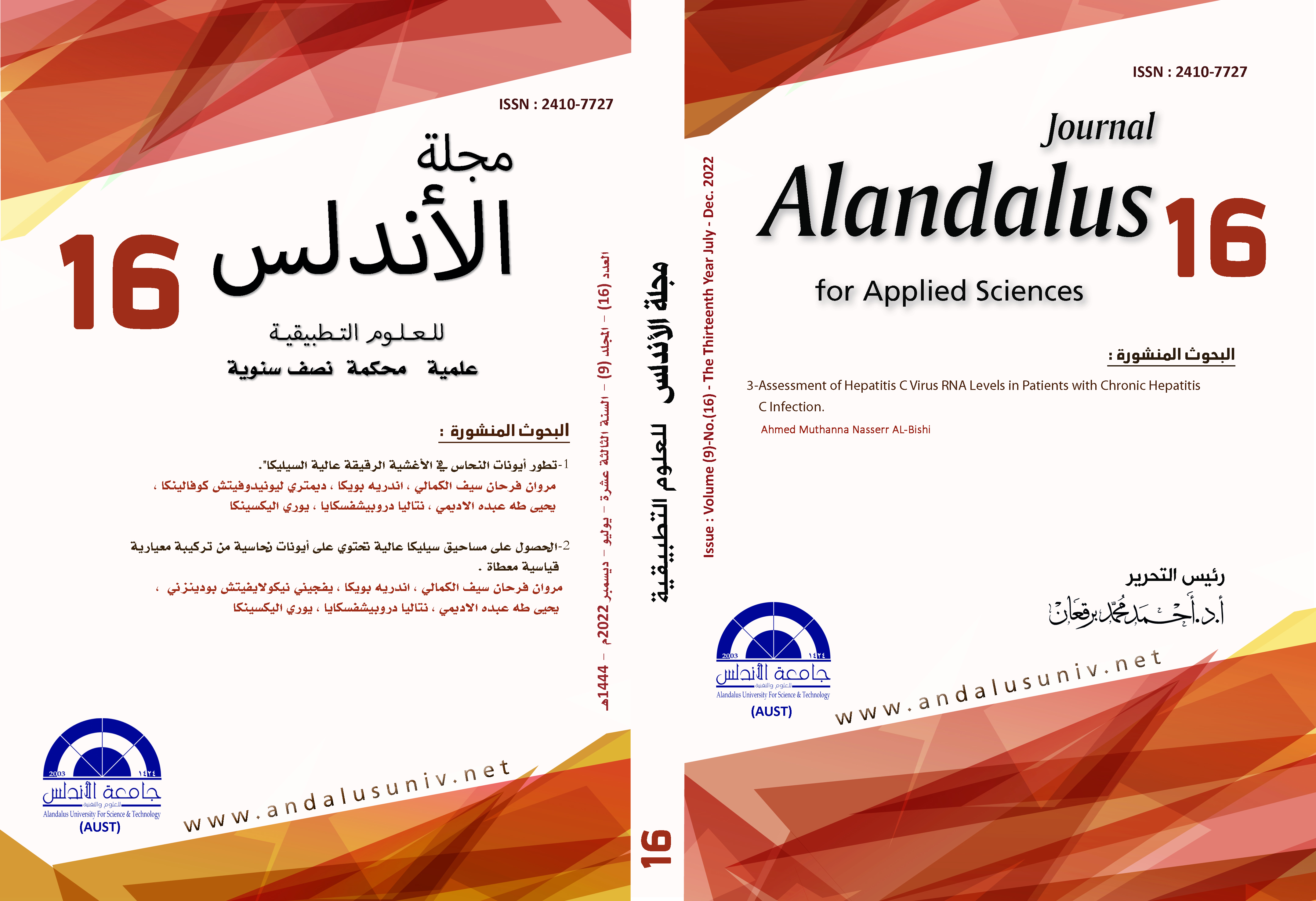OBTAINING HIGH SILICA POWDERS CONTAINING COPPER IONS OF مروان فرحان سيف الكمالي1،*، اندريه بويكا1،†، يفجيني نيكولايفيتش بودينزني2 ، يحيى طه عبده الاديمي3، نتاليا دروبيشفسكايا1،يوري اليكسينكا1.
Main Article Content
Abstract
OBTAINING HIGH SILICA POWDERS CONTAINING COPPER IONS OF A GIVEN STOICHIOMETRIC COMPOSITION
Marwan F. S. Al-Kamali1,*, Andei A. Boika1, †, Yauheni N.Paddenezhny2,
Yahya T.A. AL-Ademi3, , Natallia E. Drabysheuskaya1, , Yury A. Alexeenko1,
1Laboratory of Technical Ceramics and Nanomaterials, Department of Materials Science in Mechanical Engineering, Sukhoi State Technical University of Gomel, Gomel, Belarus.
2Department of medical equipment engineering, Ph.D. & junior research assistant, Klapwijse zoom, 2652BD Berkelen Rodenrijs. Netherlands.
*Corresponding author: Marwan F. S. Al-Kamali; E-mail: marwan.ye2@gmail.com, ; marwan_ye@gstu.by Contact No.: +375 44 450 73 17.
†Corresponding author: Andrei A. Boika; E-mail: boika.andej@gmail.com, boika@gstu.by; Contact No.: +375232295934
Abstract:
The paper presents the results of studies of the Technological Stages of Obtaining High-Silica Powders Containing Copper Ions by the Sol-Gel Method. It has been shown that metal nanoparticles in a xerogel matrix are nanostructured objects with high chemical and “penetrating” activity with respect to the occurrence of thermally stimulated surface reactions, while the SiO2 matrix retains an amorphous system, whereas CuO and Cu° form a monoclinic crystalline syngony. Based on the results of SEM data, it was suggested that the reduced metal is sorbed into the globular structure of the xerogel, forming a thin composite layer on the SiO2 surface. No pronounced formation of separately localized Cu° micro- and nanoparticles was found. From the obtained high-silica SiO2:CuO and SiO2:Cuº powders, targets were formed for the deposition of thin films by electron-beam or magnetron sputtering with a diameter of up to 80 mm.
KEYWORDS: xerogel; Sol-gel; SiO2:CuO; SiO2:Cu°; Morphology; high-silica; XRD, SEM; micro-Nano powder
.
Article Details
References
المراجع والمصادر
Hench Larry L., West Jon K. The sol-gel process // Chem. Reviews. – 1990. - Vol. 90, № 1. – P. 33-72.
Hrubesh L.W., Poco J.F. Thin aerogel films for optical, thermal, acoustic and electronic applications. // J. Non-Cryst. Solids. – 1995. – Vol. 188. – P. 46-53.
Segal D.L. Sol-gel processing: routes to oxide ceramics using colloidal dispersions of hydrous oxydes and alkoxyde intermediates // J.Non-Cryst. Solids. – 1984. - Vol.63. - P.183-191.
Sheppard, L.M. Low-Temperature Synthesis of Ceramics // Adv. Vat. and Process. inc. Metal Progr. – 1986. – Vol.130, №5. – P.47-51
Ogihara T. Hydrolysis of Metal Alkoxides in Homogeneous Solutions // in Fine Particles Synthesis, Characterisation and Mehanism of Gronth/ Ed. T.Sugimoto. – N.-Y., Basel. – 2000. – P.35-57.
Arbenin A. Yu., Zemtsova E. G., Smirnov V. M. Synthesis of iron nanoparticles in mesoporous silica sba-15 and chemical composition analysis. Vestnik Sankt-Peterburgskogo universiteta. Fizika i khimiya = Vestnik of Saint Petersburg University. Physics and Chemistry, 2012, vol. 4, pp. 136–138 (in Russian).
AL-Kamali M.F.S.H. Alekseenko A.A., Titenkov О.А. Structure formation of SiO2-xerogels containing copper compounds of different phase composition // Scientific and technical journal «problems of physics, mathematics and technics». - 2020. - № 3 (44). – P.7-12. (In Russ.).
Al-Kamali M. F. S. H., Boika A. A., Al-Shamiri H. A. S. SiO2:CuO (Cu°) targets for depositing thin films of ion-beam spraying obtained by sol-gel method. Doklady Natsional’noi akademii nauk Belarusi = Doklady of the National Academy of Sciences of Belarus, 2022, vol. 66, no. 3, pp. 348–355 (in Russian). https://doi.org/10.29235/1561-8323-2022-66-3-348-355
Al-Kamali M.F.S.H., Zalizny D.I., Boika A.A., Fedosenko N.N. Electrical properties of SiO2:Cuº thin films produced by pulse laser deposition, problems of physics mathematics and technics( Francisk Skorina Gomel State University),2022, № 2(51) p. 7-11 (in Russian).
Structural properties of micropowders composition SiO2:CuO & SiO2:Cu° prepared by sol-gel method / M.F.S.H. AL-Kamali [et al.] // Al-Andalus J. Appl. Scien. – 2021. – № 13 (January –June). – P. 99–117.
Poddenezhny Е. N., Boiko A. A.. Sol-gel synthesis of optical quartz glass. Gomel, 2002. 210 p. (in Russian).
Villa N., Golosov D. A., Nguyen T. D. Formation of titanium oxide thin films by reactive magnetron sputtering. Doklady BGUIR, 2019, no. 5 (123), pp. 87–93 (in Russian). https://doi.org/10.35596/1729-7648-2019-123-5-87-93.
Evstropiev S.K., Nikonorov N.V. Liquid Methods for Obtaining Optical Nanomaterials: Study book - Saint Petersburg: ITMO University, 2018. - p. 84. (in Russian).
Semchenko A.V., Sidsky V.V., Tyulenkova O.I. Study of the sorption properties of silica gels obtained by the sol-gel method, Problems of physics, mathematics and technology. - 2018. - No. 1 (34). - pp. 38-40.(in Russian).
